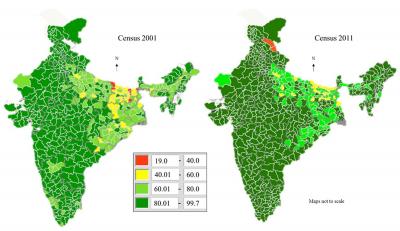
Quality and the quantum of energy consumption is a barometer of the progress of any society, today. Household energy consumption is an important subset of this and within it the household electricity consumption. The nature of this consumption can be studied at four distinct levels; access, availability, adequacy and quality. Is the electricity accessible in the first place? If accessible, is the electricity available for consumption when needed and is it adequate for the purpose at hand? Finality, the quality and reliability - interrupted versus uninterrupted, voltage variations, dependency on backup systems such as inverters or alternatives such as solar home lighting systems, lanterns, etc. This issue assumes importance in the context of the ambitious goal of supplying 24x7 electricity to every household by 2022. Access to electricity has considerably improved in a geographical sense, during the last decade (2005 onwards). Census map of districts in India, where more than 75 % households had access to electricity across the two decades, 2001 and 2011 illustrates this rather clearly (Fig. 1 & 2) though rural India fares poorly. Similarly, southern Indian states and hilly states have fared quite well in this regard, but not the non-hilly regions of central and northern India. Spatial data does not reveal the consumption disparities by income levels. For this, the NSSO survey data comes in handy. Analysis of the NSSO 68th round data at the all India level (Fig. 3) brings out several features of this inequality. We see a robust correlation between household electricity consumption and the AMPCE. We also see the gap between the levels of rural and the urban consumption. More importantly, the consumption of the richest rural decile is comparable with that of just the 6th urban decile from the bottom and more about half of the rural population consumes less than the bare minimum electricity. Such a skewed distribution becomes even more glaring when we compare across the states (Fig. 4). The urban consumption in Bihar state is similar to the rural consumption of Andhra Pradesh,while the poorest rural consumers in Punjab consume more electricity than the rich of Bihar and Andhra Pradesh. The repeating pattern and inequality across the states and regions should worry the policy makers and planners.
Prof. Satish B Agnihotri
Prof. Anand B Rao
